
Amici
Kok Chen, W7AY [w7ay (at) arrl (dot) net]
Last updated: September 21, 2012
Introduction
Amici is an audio Spectrum Analyzer/Tracking Generator application for Mac OS X.
Amici requires Mac OS X 10.6 (Snow Leopard) or newer to run on. The application and Xcode project can be downloaded from here.
Amici is not a supported product.
Both the Amici application and the Xcode project are completely free. Amici does not make use of any GPL sources and you can add functionality that you need to the program, or take portions from of the code to use in other programs, without any restrictions and without requirement to publicly publish any of the changes that you have made. The audio interface uses the Audio Library framework, which can be obtained from here.
Amici saves its property list (plist) file as w7ay.Amici.plist in the Preferences folder of the Library folder that is in your home directory. Other than the plist file and the screenshots and reference plots that are generated upon request, Amici does not create any other files.
General
The following figure shows a typical Amici window:

Figure 1 -- Amici
Window
The window can be resized to
reasonable sizes by selecting and dragging the triangle at
the lower right corner of the window.
Parameters and functions that are associated with a
spectrum analyzer (e.g., frequency and bandwidth
parameters, display appearance, etc) are built into panels
and drawers which are opened by a column of skeuomorphic
function buttons on the right side of the window.
Traditional operating system related functions (importing
or exporting a reference file, printing, etc) are accessed
through the Mac OS menu bar.
Appearance
The Setup button opens a panel that controls the appearance of the spectrum display.
The Colors box contains color
wells that determine the colors for different components of
the Amici window. To change the color of a component,
click
once in the
color well and the familiar Color Picker window will be
displayed. Do not double click on a color well —
because of an idiosyncrasy in Mac OS X, a color well
becomes unassociated with the Color Picker when you double
click on the well.
The Window
Background color is the background color
of the right side of the window which is under the column
of buttons.
There are two sets of colors
that can be picked for the actual spectrum display. One set
of colors is used for on-screen display, and the second set
is use as colors for printing, or when saving a plot to a
file. You can print and save with the same colors that
appear on the screen by selecting the Use Display colors for
printing checkbox that is in the
Save/Print Parameters box on the right side of the Amici
Setup panel.
Printing
and Saving Screen Shots
You can save the display to an image file by using the Save button on the lower right side of the Amici window. You can set the size and image format of the file. In addition, you can write a resolution-independent PDF file by going through the print dialog.
Figure 3 shows a saved spectrum using the Print/Save colors that are shown in Figure 2 but with the Use Display colors for printing checkbox unselected. The figure also shows the border that is drawn when the Add Border checkbox is selected (the border is drawn using the graticule color). The print border is never drawn when display colors are selected for printing. Notice that the default print colors that are shown in Figure 2 are chosen to save ink/toner and quite suitable for black/white printers.
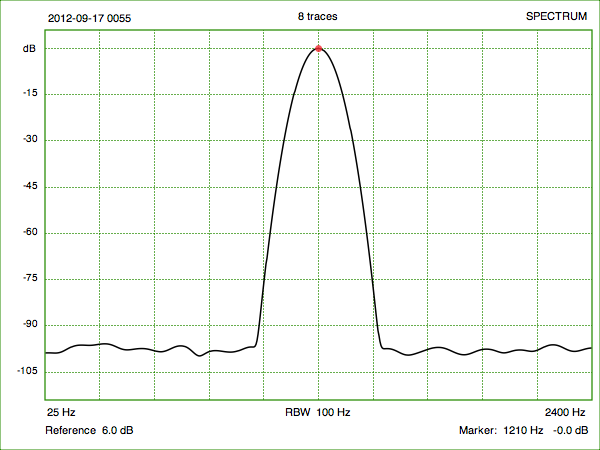
Figure 3: Print/Save
Colors (with border)
In the above figure, a
Date/time time stamp (YYYY-MM-DD HHMM) is added to the top
left of the spectrum display. You can choose not to output
the time stamp by unselecting the Show Date/time
checkbox in the Display Options box of
the Setup panel. A plot title can also be drawn at the top
right of the spectrum display. The title is defined with
the Title
text field in the
Display Options box. This text field can be left empty. The
time stamp and plot title shows up in both the display and
the print/save versions.
As shown in Figure 2, the size of a saved image is set with
the Width
and
Height
text fields. This
size is independent from the size of the Amici window
itself.
The Save
Format menu allows you to choose
between PNG, TIFF or JPEG file formats. When saving a plot,
the Base
Name text field determines where the
path name of the written file. Amici will append a date and
time and also add a suffix (.png, .tif or .jpg) to the base
name for use as the complete file name.
You can send a plot directly to a printer by
selecting Print...
in the
File menu of
the Mac OS X Menu bar, or by using the Command-P keyboard
shortcut.
Like any other Mac OS X programs, you can direct the output
to a PDF file instead of sending the output to the printer
by choosing the Print To PDF...
option in the Mac
OS X print dialog. Amici generates a resolution independent
PDF output that can be scaled to an arbitrarily large size
without losing resolution.
Spectrum
Analyzer Input
Amici takes input from the Macintosh's built-in audio inputs, or from an external USB or FireWire sound card.
The Device button on the right of the Amici window opens up the input sound card drawer.
You can close the drawer by pressing the Device button again, or by dragging the drawer's vertical edge. A drawer is also closed when you open a different drawer. Figure 4 shows the opened Device drawer.

Figure 4: Input Sound Card
Drawer
The A/D converter or codec of a
sound card can often select between different physical
inputs. These inputs are called sources.
The codec can only receive input from a single source at a
time. For example, the microKeyer II has a single input
codec that can either be routed to its microphone input or
to its external line input. In the case of the microKeyer,
the Source
popup menu is used
to select between the two sources. If the sound card has
only one source, Amici will show it in the source popup
menu as "Default."
Unlike sources, a multi-channel sound card
can
simultaneously
access more than one input channel. For stereo devices, the
Channel popup menu will show L (left) or R (right)
channels. The Channel popup menu for sound cards with more
than 2 channels will use an integer number to identify the
channel. Except for low level cross-talk, one channel of a
codec will not see the input from a different channel. With
sound cards that accept stereo phone plugs, the left
channel is usually wired to the tip of the phone jack and
the right channel is wired to the ring of the jack, with
the jack's sleeve acting as a common ground return for the
stereo signal.
Sound cards usually support multiple sampling rates. Unless
you are measuring signals that are above 20 kHz, it is
recommend that you keep the sampling rate at 48000 Hz or
lower. Lower sampling rates result in lower processor
usage. To measure signals up to N Hertz, you must use a
sampling rate that is at least 2N samples/second.
Practically all sound cards are uncalibrated devices. Amici
uses the full scale numerical value from the sound card,
together with a user settable attenuator field in
the Attenuator
drawer, to
establish the 0 dB reference.
Some sound cards comes with a digitally controlled
attenuator that is associated with the Attenuator
slider shown in
Figure 4. The sound card attenuator can sometimes be useful
for keeping a fixed input signal from saturating the input
of a sound card. If an attenuator is not present, Amici
will disable the slider (the slider will be grayed out). Be
mindful that the slider further alters the reference level
of the measured spectrum.
The sound card must never be allowed to clip or saturate.
When that happens, the input signal produces nonsensical
spectra.
Attenuator
and Plot Scale
Even though sound cards may not have an absolute full scale value, you can still use Amici to make relative readings as long as you keep the device attenuator's slider unchanged. As long as you don't remove an external sound card, Amici will try to maintain the same sound card selection and slider value each time the application is relaunched.
Given a constant input that drives the sound card to full scale, Amici's plot can be adjusted to read 0 dB by setting the Reference Level text field in the Attenuator drawer, seen in Figure 5 below.
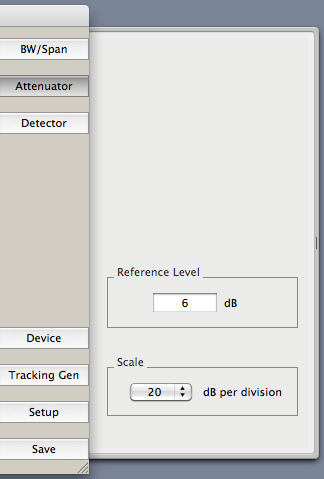
Figure 5: Attenuator
Drawer
When the Reference Level is set
to 0 dB, Amici presents a full scale sinusoid from the
sound card, right before the sound card clips, as a 0 dB
level on its display.
For most sound cards, this full scale level is an imprecise
value, and sound card manufacturers usually do not even
dare to publish it in their spec sheets.
(Most
sound cards have a
full scale around
0
dBu.) However, it will likely
to also change depending upon the attenuator slider
setting, whose position may or may not bear an accurate
relationship to the number of dB of actual attenuation.
Moreover, some sound cards have a separate microphone
and line level input, and the relative gain between them
is also an imprecise value.
For this reason, Amici's vertical scale is labeled simply
as dB relative to some unspecified value. The actual
reference will depend on the sound card's full scale level,
the sound card's attenuator setting, and the Reference
Level field that is shown in Figure 5.
As long as you don't switch to a different sound card, does
not change the attenuator slider of the sound card (or let
another application change it), and don't change the
Reference Level field, you can
make
meaningful relative
readings between
devices that you are testing.
You can set the vertical scale of the plot to 1, 2, 3, 6,
10, 15, 20 or 30 dB per division with the
Scale
popup menu shown in
the above figure. The following two figures show the
displays that are set to 15 dB per division and 20 dB per
division, respectively:
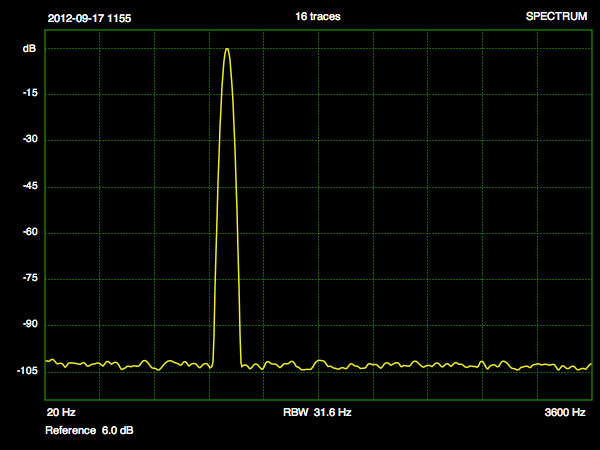
Figure 6: 15 dB per
Division
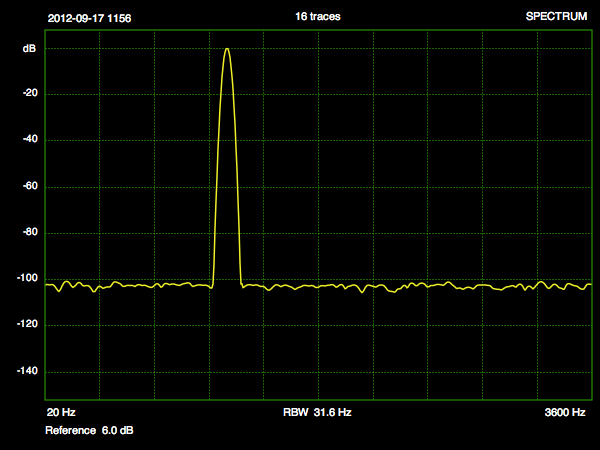
Figure 7: 20 dB per
Division
The next figure shows the same
20 dB per division scale, but with Reference Level field in
the Attenuation drawer reduced by 10 dB. Notice that this
shifts the entire plot down by 10 dB relative to the grid
lines.
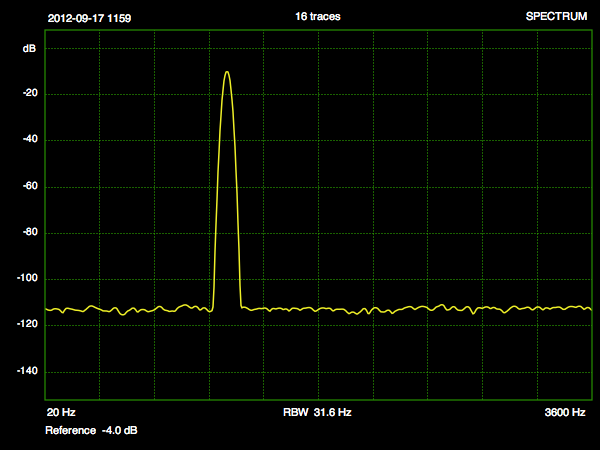
Figure 8: 20 dB per
Division with an additional -10 dB change to Reference
Level
If the Reference Level field or
Scale popup menu settings cause the trace to fall either
completely above or completely below the display area,
Amici draws a gray warning bar at the top or the bottom of
the plot, respectively. Figure 9 shows the appearance when
the entire trace falls below the display (-75 dB in this
case).

Figure 9: Gray Warning Bar when
trace falls completely below the
Display
While Amici uses the Fast Fourier Transform (FFT) to estimate the power spectrum, it does not depend solely on the FFT to provide the resolution bandwidth that is desired in a spectrum analyzer.
When a 16,384-point FFT is performed on a 48,000 sample/second to produce 8,192 frequency bins, the resultant bins are separated from one another by 2.929 Hz. Each bin has a transfer function in the frequency domain that has the shape of a sin(f)/f function, with the zeros of the function occurring precisely at the center of bins other than itself. Each of these FFT bins also has an equivalent noise bandwidth of 2.929 Hz.
The sin(f)/f transfer function from a raw FFT causes a signal that is not located precisely at the center of an FFT bin to also appear at frequency bins that are far away from the true signal.
Further, it is also desirable for a spectrum analyzer to have selectable noise bandwidth that is different from the natural bandwidth which is determined by the size of an FFT and the sampling rate (i.e., the 2.929 Hz in the example cited above). A noise bandwidth of precisely 1 Hz is especially desirable for the purpose of directly measuring the noise floor of a device and thus being able to directly read out the dynamic range. Noise floors are usually specified in units of dB/Hz.
For these two reasons, Amici applies a calibrated window to the data before performing an FFT on the waveform. To provide a variety of filter skirts, Amici lets you choose between a Hann window, a Blackman window and a Gaussian window.
To create a known bandwidth that is different from the native FFT bin's bandwidth with the Hann and Blackman windows, the support of the window functions are constructed to be narrower than the FFT width. With the Gaussian window, the standard deviation of the Gaussian function provides the bandwidth factor.
Of the three windows available in Amici, the Hann window provides the steepest initial filter skirt, but its sidelobes eventually flare out appreciably.
Although a Hann window produces much lower sidebands than the sin(x)/x sidebands from a unwindowed FFT, it is still not useful for making noise floor and IMD measurements that require a dynamic range of more than about 60 dB.
For the same noise bandwidth, the Gaussian window has a wider initial bandwidth than the Hann, but then drops steeply to more than 140 dB at about 3 times the noise bandwidth away from the peak.
Finally, the Blackman window has a behavior somewhere in between the Hann and the Gaussian.
The following three figures show the behavior of the Hann, Blackman and Gaussian windows, respectively. The window types are shown as the title at the top right hand corner of each figure. All three windows shown here have the same equivalent noise bandwidth of 31.6 Hz, and all windows are plotted to the same scale.
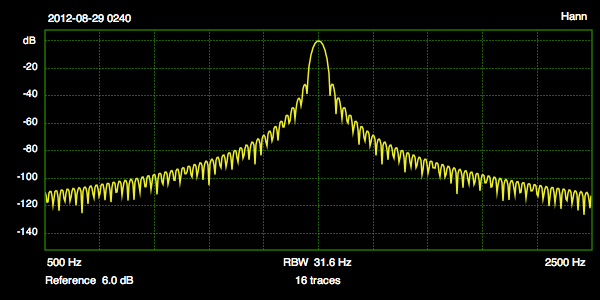
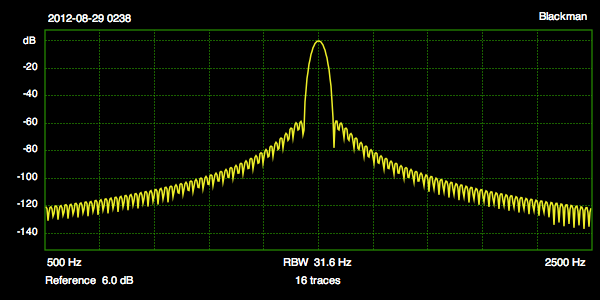

One way to interpret the
figures above is that a Hann window is better at separating
close spaced tones as long as you do not require a dynamic
range that is better than 40 dB.
Amici's Gaussian window, on the other hand is capable of
measuring noise floors and IMD in excess of 140 dB (up to
the numerical accuracy of single precision floating point
FFT) below a reference carrier, but it requires narrower
noise bandwidths than the Hann window (and thus more
processor cycles due to the need to compute larger FFTs) to
resolve two close spaced tones.
The
Blackman window is included in Amici to give a solution
that sits somewhere between the Hann and the Gaussian.
When processor utilization is not a problem, and if tone
separations are greater than 10 times the resolution
bandwidth of the filter, it is recommended that you select
the Gaussian window.
Figure 10 below shows the
bandwidth
and FFT
window
popup menus in
the Bandwidth/Span drawer.

Figure 10: Bandwidth/Span
Drawer
The bandwidth menu provides calibrated noise bandwidths of
1 Hz, 3.16 Hz, 10 Hz, 31.6 Hz and 100 Hz (these are
equivalent noise bandwidths in 5 dB steps, and accurate to
within about 0.1 dB).
The dynamic range of a device can, for example be read
directly off the display by using a full scale tone and
reading the noise floor using a 1 Hz bandwidth, or it can
be measured by using 3.16 Hz bandwidth and adding 5 dB to
the result, etc.
The fields in the Span
box let you set the
lowest and highest frequencies that are displayed. The
upper frequency has to be less than one half the sampling
rate i.e., the Nyquist frequency.
Because sound cards do not work at or near DC, the lower
frequency is limited by the program to 9 Hz. The specific
sound card that you use may require you to use a larger
limit for the lower frequency before the measurement is
meaningful.
The noise bandwidth menu specifies the Resolution Bandwidth
(RBW) of the spectrum analyzer. (The Agilent Application Note (150) on RF
spectrum analyzers is a good reference to learn
spectrum analyzer concepts and terms.)
Unlike many older (RF) spectrum analyzers, Amici does not
perform video filtering. To smooth the display noise, Amici
instead uses
Trace Averaging (see above Agilent application note
for the
definition of trace averaging). The number of traces
that are averaged is set by the Trace
Average field in Figure 10; trace
average of 1 is equivalent to no averaging. Each
doubling of the number of averaged traces improves the
noise of the displayed trace by 3 dB.
The averaged trace is reset each time any Amici parameter
that affects the spectrum (e.g., resolution bandwidth)
changes. When that happens, the number of averages starts
over again with a single trace. Traces are accumulated as
each new spectrum arrives, until the number of traces
reaches the number of traces that is requested. A per-bin
exponential moving average is used to produce the averaged
data. The current number of averaged traces is reported
above the center of the display.
Detector
As mentioned above, the size of the underlying FFT in Amici is determined by the resolution bandwidth and the type of FFT window.
With a Hann window, each FFT bin has to be at least 1.5 times narrower than the desired resolution bandwidth. With a Blackman window, each FFT bin has to be 1.728 times narrower than the desired resolution bandwidth. With the Gaussian window, each FFT bin has to be 1.808 times narrower than the desired resolution bandwidth.
With a typical frequency span and display size, there can also be many FFT bins per horizontal pixel on the display. Typically, this means that many FFT bins will map to a single pixel on the display.
How the multiple FFT bins map to a single pixel that is drawn is determined by the detection method. Amici lets you select between positive peak, negative peak, average, rosenfell and "normal" detection methods from the popup menu in the Detector drawer.
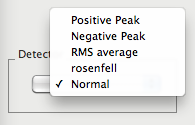
Figure 11: Detector
Menu
The Agilent application note
has a section
which describes various detection modes used in spectrum
analyzers. They will only be briefly mentioned here,
together with hints on where each detector is useful in
the context of audio measurements.
With positive peak
detection, the detector picks the
largest value from the set of FFT bins that are mapped to a
single pixel — this detector is especially useful for
accurately measuring the peak power of a narrow tone. It is
also useful for accurately determining the higher bound of
a passband ripple. The positive peak detector can however
misrepresent noise floor measurements by a substantial
amount.
With negative peak
detection, the detector picks the
smallest value from the set of FFT bins that are mapped to
a single pixel — this detector not only
underestimates the noise floor, it also almost always fail
to provide the correct peak value of a narrow tone. It can
be useful however, when there is a need to accurately
determine of the lower bound of a passband ripple.
With average
detection, the detector computes the RMS
average of the set of FFT bins that are mapped to a single
pixel — this is more accurate than both the peak
detectors for measuring a mostly constant noise floor of a
device. The average detector invariably fails however to
provide the correct power of a narrow tone.
Neither of the peak detectors are good in regions where the
signal-to-noise ratio is poor, while the average detector
fails when the spectrum changes rapidly, including the peak
of a narrow tone. For this, there is the rosenfell
detector.
The rosenfell
detector displays the peak value of the
set of FFT bins if the ordered bins are always ascending or
always descending. If the FFT bins both rise and fall (thus
the name "rosenfell"), the negative peak from the set is
used if the resultant pixel is an even pixel. The positive
peak from the set of FFT bins is used if the resultant bin
is an odd pixel. The rosenfell detector will therefore
always give the correct peak power of a narrow tone,
although it can sometimes draw the peak of a tone one pixel
to the right if the tone peak happens to fall on an even
pixel. I.e., the rosenfell can produce correct peak values,
although the location of the peak can be off by one pixel
in frequency, while not over-estimating the noise floor
(the human eye can average out the positive and negative
peaks in the noise).
Amici uses a modified rosenfell detector as its "normal"
detector. Instead of using the negative peak as an even
pixel of the rosenfell detector, the normal detector
in Amici uses the
RMS average as the even pixel. This provides a slightly a
better visual estimate of the noise floor than the standard
rosenfell detector.
Many RF spectrum analyzers use the standard rosenfell as
their "normal" detector. If you want to use the rosenfell
detector in Amici, you need to select it explicitly instead
of using the "normal" detector.
Marker
In Amici, a marker is placed on a spectrum trace by using the contextual menu of a right mouse click.
First, make sure the Amici window is active. If you are not certain, you can safely click on the title bar of the window to activate Amici. If the mouse cursor is not already an arrow cursor, activating Amici should turn it into an arrow cursor.
Position the pointed end of the arrow cursor at or near the location in the spectrum trace where you wish to set a marker. Then hold down the right mouse button (if your mouse does not have a right button, you can first hold down the keyboard control key before holding down the normal mouse button). You will see a contextual menu like the one that is shown in Figure 12:
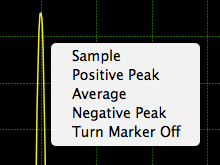
Figure 12: Marker
Contextual Menu
Once the contextual menu is visible, you can move the
cursor to one of the menu items and releasing the mouse
button.
The Sample
menu item places
the marker at a sample on the curve that is nearest to
where you had initially held the mouse button down.
A dot is drawn on the display to indicate the sample
location that is picked. The color (default color is red)
of the dot is defined by the Marker
color in the Setup
panel. The frequency and power level of the marker is shown
at the lower right of the display (-66.7 dB at 1521 Hz in
Figure 13).

Figure 13: Marker Location
and Value
Please
note that when the curve is steep, Amici may not pick the
closest point on the curve to locate the marker. The marker
is instead placed at the closest detected point.
When a new spectrum trace arrives after a sample marker has
been placed, the marker keeps the same frequency, but moves
to the new measured power level if that has changed. The
marker's textual information is also updated.
An
existing marker is removed when a new marker is selected.
You can remove a marker completely by choosing the
Turn Marker Off menu item in the contextual
menu.
The Positive Peak
marker places the
marker at the closest positive peak on the curve to the
selected point. When a new spectrum trace arrives, Amici
will update the location of the peak.
The Negative Peak
marker places the
marker at the closest negative dip on the curve to the
selected point and will similarly be updated when a new
trace arrives.
The Average
marker first
locates the closest point on the curve and then computes
the average of the trace surrounding that point. Amici
takes the average power for a frequency interval that is
approximately equal to 5% of the total displayed frequency
span and centered at the selected point, resulting in an
RMS measurement near the selected point. Amici displays the
averaged span with a translucent bar (whose vertical
location is the average power), as shown in Figure 14:
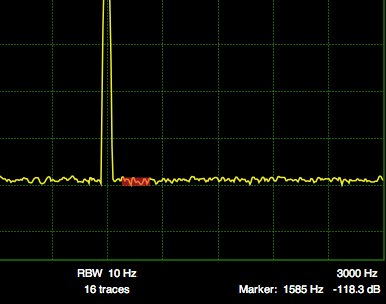
Figure 14: Average Marker
Location and Value
The selected frequency
(midpoint of the averages) and average power level are
listed at the lower right of the Amici display, as shown in
Figures 13 above.
Tracking Generator
Amici comes with a tracking generator for measuring the transfer function of filters and devices.
It is highly recommended that you first use a wider bandwidth such as 31.6 Hz for initial measurements, and reduce the bandwidth only when needed.
To use the tracking generator, feed the generator's output sound card to the input of device under test (DUT), and connect the output of the DUT back to the input of the Amici.
Figure 15 shows the Tracking Generator drawer. Like Amici's input, there is a set of parameters for the tracking generator's sound card. You need not use the output codec from the input sound card -- but be aware that there could be slight difference in actual sampling rates between two different sound cards unless one of then is synched with the other. This is not generally a problem when you set the Amici bandwidth to 10 Hz and above. You can also use the Mac OS X's Audio MIDI Setup utility to combine sound cards into an aggregate device that share the same sampling rate clock -- see here.
![]()
Figure 15: Tracking Generator
Drawer
To place Amici into tracking
generator mode, switch the radio buttons in the drawer to
"On." This will erase any previous spectrum analyzer trace
from the display. Click the Start button to start the
tracking generator. The Start button's caption will now
read "Stop." You can Stop the tracking generator and
restart the generator from the beginning by toggling the
Start/Stop button.
Amici will start the tracking generator at a frequency that
is slightly lower than the lower of the display's frequency
span. Because of that, nothing may show up for a little
while. Amici will initially display a set of gray spinning
discs at the center of the display to indicate activity.
The spinning discs are removed a short time after the
spectrum trace appears.
A vertical gray line shows the progress of the tracking
generator as it sweeps the spectrum.
Figure 16 shows both the set of spinning discs which appear
at the beginning of a tracking generator sweep and the
vertical progress line.
![]()
Figure 16: Spinning discs and
progress line of the Tracking Generator display.
The tracking generator stops at
the end of the trace and the Start/Stop indicator shows
"Start" again. Trace averaging is turned also off when
Amici is in the tracking generator mode.
If you restart the tracking generator after a trace has
completed, Amici will replace the samples on the old trace
in the display with the new trace without erasing samples
from the old trace that the tracking generator has not yet
reached in the subsequent pass. (To erase the old trace,
you can quickly toggle the state of the tracking generator
between Off and On.) The vertical gray progress line will
show where the new trace ends and where the old trace
begins.
Just like the spectrum analyzer mode, Amici allows you to
place a marker on a tracking generator trace. If you ask
for a positive peak or a negative peak and the tracking
generator has not yet reached the neighborhood peak, the
marker will follow the tracking generator's frequency until
such peck is reached. For example, if you ask for a
negative peak near the frequency the tracking generator is
on, and the measured power is still decreasing, the marker
location will follow the tracking generator.
Figure 17 shows the tracking generator output of a second
order lowpass RLC filter with a marker set for the positive
peak.
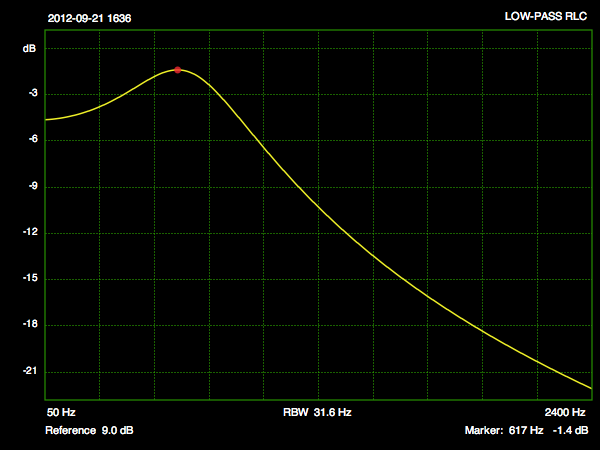
Figure 17: Lowpass RLC
filter
In addition to the ability to send the display directly to a printer, or to a PDF file, or to save the display as an image file (see Printing and Saving Screen Shots section above), Amici can also save the current spectrum to a data file that can subsequently be used as a reference plot.
Figure 18 shows the Reference menu:

Figure 18: Amici Reference Menu
Use As
Reference sets the current spectrum to be
the reference trace. The reference trace is plotted as a
curve with alternating dot and dashes. Figure 19 shows the
RLC filter of Figure 17 used as the reference, and then
restarting the tracking generator after reducing the Q of
the filter:
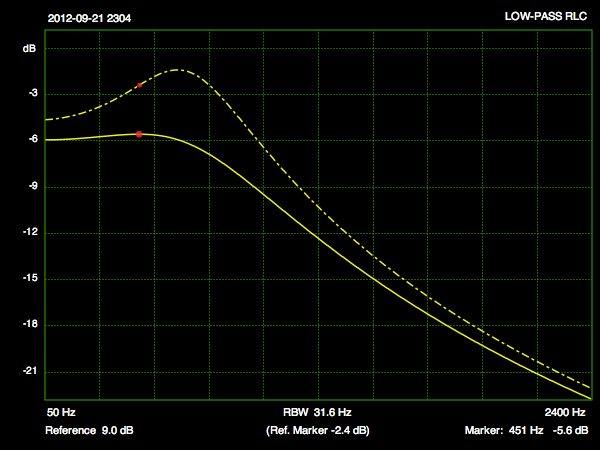
Figure 19: Spectrum (from
tracking filter) with Reference
You can export an existing
trace as an XML format file by selecting
Save Reference
to File. The exported reference can
later be imported as a reference trace by selecting
Get Reference
From File. The frequency span is also
exported, and when the reference is imported back, it will
set the span and lock it. The span will unlock when you
remove the reference.
Remove
Reference removes the reference trace.
As
seen in Figure 19 above, when you set a marker on the
current trace, it will also report the value of the
reference at the same frequency. The reference marker value
is shown at the bottom center of the display.
